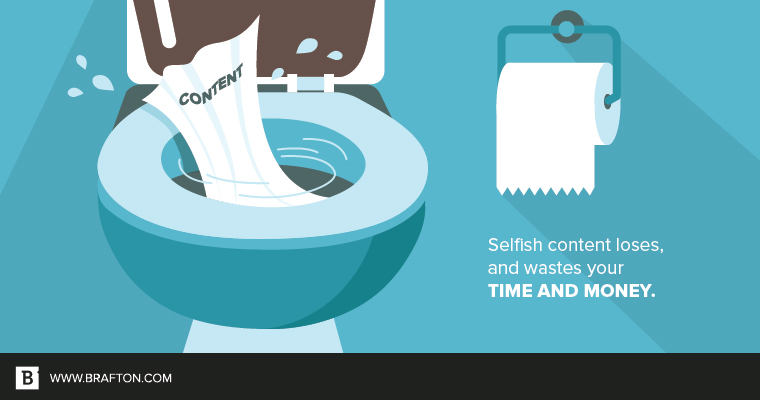You thought you had everything figured out, and that’s exactly where you went wrong.
You learned your products inside and out, learned your company values, learned about the market. Then you wrote a month’s worth of clunkers.
With all that learning going on, how in the eff could that possibly happen? Let’s break down a few ways that you and your audience passed each other in the bar without so much as a seductive glance.
1. You love yourself too much
Brace yourself. Nobody cares about your company. They never have, and never will. They care about the product or service(s) you provide and how you’re going to fix their problems. Go on if you will about “customer loyalty”, but just know that you are replaceable the second your product stops providing value.
The second you start fussing over creating content for the sake of stroking your ego, you’re done. You’re like that guy at the party who talks at you about his days of college football.
Examples:
- Assuming your audience cares about your company updates. Unless you have shareholders, or your products are changing in a way that directly impacts customers, keep them internal. I’m looking at you, Captain Press Release.
- Only writing on topics that perfectly align with your product or service. Your topics are going to get really narrow, really quickly. Then you’re beating a dead horse. Figure out how to expand your level of subject matter expertise outside your immediate line of sight.
Going outside your purview shows confidence and true interest in your audience’s concerns.
2. You’re only writing the content you want to read
One of the downfalls of getting deeply ingrained in your own brand is the myopic content it breeds. You project your own interests onto your audience.
Repeat after me: “I am not my audience.”
We tend to see this issue with the most zealous of content marketers, especially those in niche spaces — they shove their agenda down their audience’s throats expecting them to think it tastes good.
I’m afraid it only tastes good to you, and that’s okay, as long as you recognize that and pivot accordingly.
Example: A production plant operator couldn’t care less about your revolutionary Ethernet nodes that speak six different types of protocols. What they do care about is the six thousand beer bottles that exploded on Tuesday because their production line went haywire. You need to speak in Layman’s terms about what you are going to do to help this person.
You have to get outside of your brand and into your audience’s brain.
3. Your content production is constipated
This is a biggie. I’ve seen individual blogs take over four weeks of tweaking and tinkering before they finally go live on a site. You just “can’t get the voice right.” Or you “just can’t get the messaging right.” So a blog that cost $200 to write turns into a $5,000 fiasco involving the marketing manager, CMO, VP, CEO, and the poor content writer who has to incorporate four different sets of opinions into one piece.
After four weeks of spinning your wheels, you are left with a clunky Frankenstein blog post that only your employees and 18 spambots read.
An utter waste of time and resources.
Blogs are meant to be good, but they’re also meant to be churned out. Blogs are not white papers, nor are they the next great American novel. They are web logs. Period. They exist for the purpose of generating top-of-funnel interest.
In conclusion, you should have seen a theme evolving out of this article: selfish content loses, and wastes your time and money. When you start losing sight of your bread and butter — your audience — you lose them. Stop being self-absorbed and start being interesting.

Talk about how you’re going to fix the problems in my life.
Talk about something funny.
Raise an objection to the way things are being done.
Teach me something that’s going to get me a raise.
If you can’t do any of these things, put your hand down, and go back to the drawing board.





